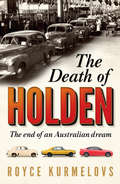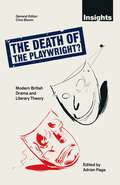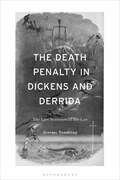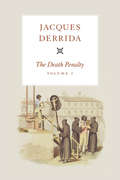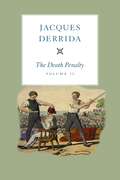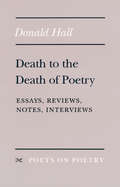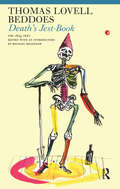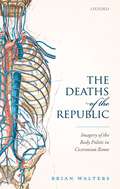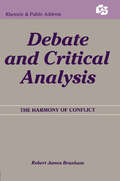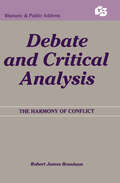- Table View
- List View
The Death of Holden: The bestselling account of the decline of Australian manufacturing
by Royce KurmelovsHolden is one of the few brands that has an emotional grip on Australia (Qantas being another). The closure of the Holden factory in Adelaide is not just the end of a business - it's the end of an era, of a story, and of a great Australian dream.When Holden signalled that it would close its Adelaide factory, it struck at the very heart of Australian identity. Holden is our car made on our shores. It's the choice of patriotic rev heads and suburban drivers alike. How could a car that was so beloved - and so popular - be so unprofitable to make?The story of the collapse of Holden is about the people who make and drive the cars; it's about sustaining industry in Australia; it's about communities of workers and what happens when the work dries up. And if it's not quite about the death of an icon - because Holdens will remain on Australian roads for a long time to come - then it's about what happens when an icon falls to knees in front of a whole nation.'Brilliant and powerful' Nick Xenophon
The Death of the Playwright?: Modern British Drama and Literary Theory (Insights)
by Adrian PageThe nine essays in this volume make significant contributions to the development of contemporary literary theory and demonstrate how a range of new approaches can be applied to modern British drama. In addressing the questions of power, subjectivity, sexuality, psychoanalysis, and the nature of the dramatic text, the contributors reveal how much modern drama can be re-read to discover its radically subversive characteristics. Their conclusions challenge accepted interpretations and suggest major revisions of the processes of understanding and staging drama.
The Death of Truth: Notes On Falsehood In The Age Of Trump
by Michiko KakutaniFrom a Pulitzer Prize-winning critic comes an impassioned critique of the West’s retreat from reason. ‘The Death of Truth is destined to become the defining treatise of our age’ David Grann ‘The first great book of the Trump administration … essential reading’ Rolling Stone
The Death Penalty in Dickens and Derrida: The Last Sentence of the Law
by Jeremy TamblingIn the nineteenth century, Charles Dickens backed the cause of abolition of the death penalty and wrote comprehensively about it, in public letters and in his novels. At the end of the twentieth century, Jacques Derrida ran two years of seminars on the subject, which were published posthumously. What the novelist and the philosopher of deconstruction discussed independently, this book brings into comparison.Tambling examines crime and punishment in Dickens's novels Barnaby Rudge, A Tale of Two Cities, Oliver Twist and Bleak House and explores those who influenced Dickens's work, including Hogarth, Fielding, Godwin and Edgar Allen Poe. This book also looks at those who influenced Derrida – Freud, Nietzsche, Foucault and Blanchot – and considers Derrida's study on terrorism and the USA as the only major democracy adhering to the death penalty.A comprehensive study of punishment in Dickens, and furthering Derrida's insights by commenting on Shakespeare and blood, revenge, the French Revolution, and the enduring power of violence and its fascination, this book is a major contribution to literary criticism on Dickens and Derrida. Those interested in literature, criminology, law, gender, and psychoanalysis will find it an essential intervention in a topic still rousing intense argument.
The Death Penalty, Volume I (The Seminars of Jacques Derrida #1)
by Jacques DerridaIn this newest installment in Chicago’s series of Jacques Derrida’s seminars, the renowned philosopher attempts one of his most ambitious goals: the first truly philosophical argument against the death penalty. While much has been written against the death penalty, Derrida contends that Western philosophy is massively, if not always overtly, complicit with a logic in which a sovereign state has the right to take a life. Haunted by this notion, he turns to the key places where such logic has been established—and to the place it has been most effectively challenged: literature. With his signature genius and patient yet dazzling readings of an impressive breadth of texts, Derrida examines everything from the Bible to Plato to Camus to Jean Genet, with special attention to Kant and post–World War II juridical texts, to draw the landscape of death penalty discourses. Keeping clearly in view the death rows and execution chambers of the United States, he shows how arguments surrounding cruel and unusual punishment depend on what he calls an “anesthesial logic,” which has also driven the development of death penalty technology from the French guillotine to lethal injection. Confronting a demand for philosophical rigor, he pursues provocative analyses of the shortcomings of abolitionist discourse. Above all, he argues that the death penalty and its attendant technologies are products of a desire to put an end to one of the most fundamental qualities of our finite existence: the radical uncertainty of when we will die. Arriving at a critical juncture in history—especially in the United States, one of the last Christian-inspired democracies to resist abolition—The Death Penalty is both a timely response to an important ethical debate and a timeless addition to Derrida’s esteemed body of work.
The Death Penalty, Volume I (The Seminars of Jacques Derrida #1)
by Jacques DerridaIn this newest installment in Chicago’s series of Jacques Derrida’s seminars, the renowned philosopher attempts one of his most ambitious goals: the first truly philosophical argument against the death penalty. While much has been written against the death penalty, Derrida contends that Western philosophy is massively, if not always overtly, complicit with a logic in which a sovereign state has the right to take a life. Haunted by this notion, he turns to the key places where such logic has been established—and to the place it has been most effectively challenged: literature. With his signature genius and patient yet dazzling readings of an impressive breadth of texts, Derrida examines everything from the Bible to Plato to Camus to Jean Genet, with special attention to Kant and post–World War II juridical texts, to draw the landscape of death penalty discourses. Keeping clearly in view the death rows and execution chambers of the United States, he shows how arguments surrounding cruel and unusual punishment depend on what he calls an “anesthesial logic,” which has also driven the development of death penalty technology from the French guillotine to lethal injection. Confronting a demand for philosophical rigor, he pursues provocative analyses of the shortcomings of abolitionist discourse. Above all, he argues that the death penalty and its attendant technologies are products of a desire to put an end to one of the most fundamental qualities of our finite existence: the radical uncertainty of when we will die. Arriving at a critical juncture in history—especially in the United States, one of the last Christian-inspired democracies to resist abolition—The Death Penalty is both a timely response to an important ethical debate and a timeless addition to Derrida’s esteemed body of work.
The Death Penalty, Volume I (The Seminars of Jacques Derrida #1)
by Jacques DerridaIn this newest installment in Chicago’s series of Jacques Derrida’s seminars, the renowned philosopher attempts one of his most ambitious goals: the first truly philosophical argument against the death penalty. While much has been written against the death penalty, Derrida contends that Western philosophy is massively, if not always overtly, complicit with a logic in which a sovereign state has the right to take a life. Haunted by this notion, he turns to the key places where such logic has been established—and to the place it has been most effectively challenged: literature. With his signature genius and patient yet dazzling readings of an impressive breadth of texts, Derrida examines everything from the Bible to Plato to Camus to Jean Genet, with special attention to Kant and post–World War II juridical texts, to draw the landscape of death penalty discourses. Keeping clearly in view the death rows and execution chambers of the United States, he shows how arguments surrounding cruel and unusual punishment depend on what he calls an “anesthesial logic,” which has also driven the development of death penalty technology from the French guillotine to lethal injection. Confronting a demand for philosophical rigor, he pursues provocative analyses of the shortcomings of abolitionist discourse. Above all, he argues that the death penalty and its attendant technologies are products of a desire to put an end to one of the most fundamental qualities of our finite existence: the radical uncertainty of when we will die. Arriving at a critical juncture in history—especially in the United States, one of the last Christian-inspired democracies to resist abolition—The Death Penalty is both a timely response to an important ethical debate and a timeless addition to Derrida’s esteemed body of work.
The Death Penalty, Volume I (The Seminars of Jacques Derrida #1)
by Jacques DerridaIn this newest installment in Chicago’s series of Jacques Derrida’s seminars, the renowned philosopher attempts one of his most ambitious goals: the first truly philosophical argument against the death penalty. While much has been written against the death penalty, Derrida contends that Western philosophy is massively, if not always overtly, complicit with a logic in which a sovereign state has the right to take a life. Haunted by this notion, he turns to the key places where such logic has been established—and to the place it has been most effectively challenged: literature. With his signature genius and patient yet dazzling readings of an impressive breadth of texts, Derrida examines everything from the Bible to Plato to Camus to Jean Genet, with special attention to Kant and post–World War II juridical texts, to draw the landscape of death penalty discourses. Keeping clearly in view the death rows and execution chambers of the United States, he shows how arguments surrounding cruel and unusual punishment depend on what he calls an “anesthesial logic,” which has also driven the development of death penalty technology from the French guillotine to lethal injection. Confronting a demand for philosophical rigor, he pursues provocative analyses of the shortcomings of abolitionist discourse. Above all, he argues that the death penalty and its attendant technologies are products of a desire to put an end to one of the most fundamental qualities of our finite existence: the radical uncertainty of when we will die. Arriving at a critical juncture in history—especially in the United States, one of the last Christian-inspired democracies to resist abolition—The Death Penalty is both a timely response to an important ethical debate and a timeless addition to Derrida’s esteemed body of work.
The Death Penalty, Volume II (The Seminars of Jacques Derrida)
by Jacques DerridaIn the first volume of his extraordinary analysis of the death penalty, Jacques Derrida began a journey toward an ambitious end: the first truly philosophical argument against the death penalty. Exploring an impressive breadth of thought, he traced a deeply entrenched logic throughout the whole of Western philosophy that has justified the state’s right to take a life. He also marked literature as a crucial place where this logic has been most effectively challenged. In this second and final volume, Derrida builds on these analyses toward a definitive argument against capital punishment. Of central importance in this second volume is Kant’s explicit justification of the death penalty in the Metaphysics of Morals. Thoroughly deconstructing Kant’s position—which holds the death penalty as exemplary of the eye-for-an-eye Talionic law—Derrida exposes numerous damning contradictions and exceptions. Keeping the current death penalty in the United States in view, he further explores the “anesthesial logic” he analyzed in volume one, addressing the themes of cruelty and pain through texts by Robespierre and Freud, reading Heidegger, and—in a fascinating, improvised final session—the nineteenth-century Spanish Catholic thinker Donoso Cortés. Ultimately, Derrida shows that the rationality of the death penalty as represented by Kant involves an imposition of knowledge and calculability on a fundamental condition of non-knowledge—that we don’t otherwise know what or when our deaths will be. In this way, the death penalty acts out a phantasm of mastery over one’s own death. Derrida’s thoughts arrive at a particular moment in history: when the death penalty in the United States is the closest it has ever been to abolition, and yet when the arguments on all sides are as confused as ever. His powerful analysis will prove to be a paramount contribution to this debate as well as a lasting entry in his celebrated oeuvre.
The Death Penalty, Volume II (The Seminars of Jacques Derrida)
by Jacques DerridaIn the first volume of his extraordinary analysis of the death penalty, Jacques Derrida began a journey toward an ambitious end: the first truly philosophical argument against the death penalty. Exploring an impressive breadth of thought, he traced a deeply entrenched logic throughout the whole of Western philosophy that has justified the state’s right to take a life. He also marked literature as a crucial place where this logic has been most effectively challenged. In this second and final volume, Derrida builds on these analyses toward a definitive argument against capital punishment. Of central importance in this second volume is Kant’s explicit justification of the death penalty in the Metaphysics of Morals. Thoroughly deconstructing Kant’s position—which holds the death penalty as exemplary of the eye-for-an-eye Talionic law—Derrida exposes numerous damning contradictions and exceptions. Keeping the current death penalty in the United States in view, he further explores the “anesthesial logic” he analyzed in volume one, addressing the themes of cruelty and pain through texts by Robespierre and Freud, reading Heidegger, and—in a fascinating, improvised final session—the nineteenth-century Spanish Catholic thinker Donoso Cortés. Ultimately, Derrida shows that the rationality of the death penalty as represented by Kant involves an imposition of knowledge and calculability on a fundamental condition of non-knowledge—that we don’t otherwise know what or when our deaths will be. In this way, the death penalty acts out a phantasm of mastery over one’s own death. Derrida’s thoughts arrive at a particular moment in history: when the death penalty in the United States is the closest it has ever been to abolition, and yet when the arguments on all sides are as confused as ever. His powerful analysis will prove to be a paramount contribution to this debate as well as a lasting entry in his celebrated oeuvre.
The Death Penalty, Volume II (The Seminars of Jacques Derrida)
by Jacques DerridaIn the first volume of his extraordinary analysis of the death penalty, Jacques Derrida began a journey toward an ambitious end: the first truly philosophical argument against the death penalty. Exploring an impressive breadth of thought, he traced a deeply entrenched logic throughout the whole of Western philosophy that has justified the state’s right to take a life. He also marked literature as a crucial place where this logic has been most effectively challenged. In this second and final volume, Derrida builds on these analyses toward a definitive argument against capital punishment. Of central importance in this second volume is Kant’s explicit justification of the death penalty in the Metaphysics of Morals. Thoroughly deconstructing Kant’s position—which holds the death penalty as exemplary of the eye-for-an-eye Talionic law—Derrida exposes numerous damning contradictions and exceptions. Keeping the current death penalty in the United States in view, he further explores the “anesthesial logic” he analyzed in volume one, addressing the themes of cruelty and pain through texts by Robespierre and Freud, reading Heidegger, and—in a fascinating, improvised final session—the nineteenth-century Spanish Catholic thinker Donoso Cortés. Ultimately, Derrida shows that the rationality of the death penalty as represented by Kant involves an imposition of knowledge and calculability on a fundamental condition of non-knowledge—that we don’t otherwise know what or when our deaths will be. In this way, the death penalty acts out a phantasm of mastery over one’s own death. Derrida’s thoughts arrive at a particular moment in history: when the death penalty in the United States is the closest it has ever been to abolition, and yet when the arguments on all sides are as confused as ever. His powerful analysis will prove to be a paramount contribution to this debate as well as a lasting entry in his celebrated oeuvre.
The Death Penalty, Volume II (The Seminars of Jacques Derrida)
by Jacques DerridaIn the first volume of his extraordinary analysis of the death penalty, Jacques Derrida began a journey toward an ambitious end: the first truly philosophical argument against the death penalty. Exploring an impressive breadth of thought, he traced a deeply entrenched logic throughout the whole of Western philosophy that has justified the state’s right to take a life. He also marked literature as a crucial place where this logic has been most effectively challenged. In this second and final volume, Derrida builds on these analyses toward a definitive argument against capital punishment. Of central importance in this second volume is Kant’s explicit justification of the death penalty in the Metaphysics of Morals. Thoroughly deconstructing Kant’s position—which holds the death penalty as exemplary of the eye-for-an-eye Talionic law—Derrida exposes numerous damning contradictions and exceptions. Keeping the current death penalty in the United States in view, he further explores the “anesthesial logic” he analyzed in volume one, addressing the themes of cruelty and pain through texts by Robespierre and Freud, reading Heidegger, and—in a fascinating, improvised final session—the nineteenth-century Spanish Catholic thinker Donoso Cortés. Ultimately, Derrida shows that the rationality of the death penalty as represented by Kant involves an imposition of knowledge and calculability on a fundamental condition of non-knowledge—that we don’t otherwise know what or when our deaths will be. In this way, the death penalty acts out a phantasm of mastery over one’s own death. Derrida’s thoughts arrive at a particular moment in history: when the death penalty in the United States is the closest it has ever been to abolition, and yet when the arguments on all sides are as confused as ever. His powerful analysis will prove to be a paramount contribution to this debate as well as a lasting entry in his celebrated oeuvre.
Death, Time and Mortality in the Later Novels of Don DeLillo (Routledge Research in American Literature and Culture)
by Philipp WolfThis book offers the first systematic study of death in the later novels of Don DeLillo. It focusses on Underworld to The Silence along with his 1984 novel White Noise, in which the fear of death dominates the protagonists most hauntingly. The study covers eight novels which mark the development of one of the most philosophical and prestigious novelists writing in English. Death, in its close relation to time, temporality and transience, has been an ongoing subject or motif in Don DeLillo’s oeuvre. His later work is shot through with the cultural and socio-psychological symptoms and responses death elicits. His ‘reflection on dying’ revolves around defensive mechanisms and destruction fantasies, around immortalism and cryonics, covert and overt surrogates, consumerism and media, the mortification of the body. His characters give themselves to mourning, are afflicted with psychosis, depression and the looming of emptiness. Yet writing about death also means facing the ambiguity and failing representability of ‘death.’ The book considers DeLillo’s use of language in which temporality and something like ‘death’ may become manifest. It deals with the transfiguration of time and death into art, with apocalypse as a central and recurring subject, and, as a kind of antithesis, epiphany. The study eventually proposes some reflections on the meaning of death in an age fully contingent on media and technology and dominated by financial capitalism and consumerism. Despite all the distractions, death remains a sinister presence which has beset the minds not only of DeLillo’s protagonists.
Death, Time and Mortality in the Later Novels of Don DeLillo (Routledge Research in American Literature and Culture)
by Philipp WolfThis book offers the first systematic study of death in the later novels of Don DeLillo. It focusses on Underworld to The Silence along with his 1984 novel White Noise, in which the fear of death dominates the protagonists most hauntingly. The study covers eight novels which mark the development of one of the most philosophical and prestigious novelists writing in English. Death, in its close relation to time, temporality and transience, has been an ongoing subject or motif in Don DeLillo’s oeuvre. His later work is shot through with the cultural and socio-psychological symptoms and responses death elicits. His ‘reflection on dying’ revolves around defensive mechanisms and destruction fantasies, around immortalism and cryonics, covert and overt surrogates, consumerism and media, the mortification of the body. His characters give themselves to mourning, are afflicted with psychosis, depression and the looming of emptiness. Yet writing about death also means facing the ambiguity and failing representability of ‘death.’ The book considers DeLillo’s use of language in which temporality and something like ‘death’ may become manifest. It deals with the transfiguration of time and death into art, with apocalypse as a central and recurring subject, and, as a kind of antithesis, epiphany. The study eventually proposes some reflections on the meaning of death in an age fully contingent on media and technology and dominated by financial capitalism and consumerism. Despite all the distractions, death remains a sinister presence which has beset the minds not only of DeLillo’s protagonists.
Death to the Death of Poetry: Essays, Reviews, Notes, Interviews (Poets On Poetry)
by Donald HallDonald Hall believes that American poetry, at the present moment, thrives both in quality and in leadership. In his latest collection of essays, reviews, and interviews, Hall counters the increasingly publicized view that poetry has an ever-diminishing importance in contemporary American culture. He resents the endlessly repeated cliché that finds poetry unpopular and losing popularity. Thus: Death to the Death of Poetry. Throughout the pages of this latest offering in the Poets on Poetry series, Hall returns again and again to the theme of poetry's health, and offers essays praising contemporary poets, who serve as examples of poetry's thriving condition. In addition, Death to the Death of Poetry collects interviews in which Hall discusses the work of poetry--revisions, standards, the psychology and sociology of the poet's life. The collection will be warmly received by Donald Hall's large readership, enhanced in 1993 by publication of two exemplary volumes: The Museum of Clear Ideas, his eleventh book of poetry; and his essay Life Work, which brought him both new and returning readers. Donald Hall holds degrees from Harvard and Oxford and was recipient of the Lamont Poetry Selection Award, poetry editor for the Paris Review, and Professor of English, University of Michigan, before returning to his ancestral home in New Hampshire.
Death's Jest Book: The 1829 Text (Fyfield Bks.)
by Thomas Lovell BeddoesThis book is Thomas Lovell Beddoes's defining text, a pastiche Renaissance tragedy replete with treachery, murder, sorcery and haunting, the extravagant expression of the poet's lifelong obsession with mortality and immortality. It is a classic of the literature of death.
Death's Jest Book
by Michael BradshawThis book is Thomas Lovell Beddoes's defining text, a pastiche Renaissance tragedy replete with treachery, murder, sorcery and haunting, the extravagant expression of the poet's lifelong obsession with mortality and immortality. It is a classic of the literature of death.
The Deaths of Seneca
by James KerThe forced suicide of Seneca, former adviser to Nero, is one of the most tortured--and most revisited--death scenes from classical antiquity. After fruitlessly opening his veins and drinking hemlock, Seneca finally succumbed to death in a stifling steam bath, while his wife Paulina, who had attempted suicide as well, was bandaged up and revived by Nero's men. From the first century to the present day, writers and artists have retold this scene in order to rehearse and revise Seneca's image and writings, and to scrutinize the event of human death. In The Deaths of Seneca, James Ker offers the first comprehensive cultural history of Seneca's death scene, situating it in the Roman imagination and tracing its many subsequent interpretations. Ker shows first how the earliest accounts of the death scene by Tacitus and others were shaped by conventions of Greco-Roman exitus-description and Julio-Claudian dynastic history. At the book's center is an exploration of Seneca's own prolific writings about death--whether anticipating death in his letters, dramatizing it in the tragedies, or offering therapy for loss in the form of consolations--which offered the primary lens through which Seneca's contemporaries would view the author's death. These ancient approaches set the stage for prolific receptions, and Ker traces how the death scene was retold in both literary and visual versions, from St. Jerome to Heiner Müller and from medieval illuminations to Peter Paul Rubens and Jacques-Louis David. Dozens of interpreters, engaging with prior versions and with Seneca's writings, forged new and sometimes controversial views on Seneca's legacy and, more broadly, on mortality and suicide. The Deaths of Seneca presents a new, historically inclusive, approach to reading this major Roman author.
The Deaths of Seneca
by James KerThe forced suicide of Seneca, former adviser to Nero, is one of the most tortured--and most revisited--death scenes from classical antiquity. After fruitlessly opening his veins and drinking hemlock, Seneca finally succumbed to death in a stifling steam bath, while his wife Paulina, who had attempted suicide as well, was bandaged up and revived by Nero's men. From the first century to the present day, writers and artists have retold this scene in order to rehearse and revise Seneca's image and writings, and to scrutinize the event of human death. In The Deaths of Seneca, James Ker offers the first comprehensive cultural history of Seneca's death scene, situating it in the Roman imagination and tracing its many subsequent interpretations. Ker shows first how the earliest accounts of the death scene by Tacitus and others were shaped by conventions of Greco-Roman exitus-description and Julio-Claudian dynastic history. At the book's center is an exploration of Seneca's own prolific writings about death--whether anticipating death in his letters, dramatizing it in the tragedies, or offering therapy for loss in the form of consolations--which offered the primary lens through which Seneca's contemporaries would view the author's death. These ancient approaches set the stage for prolific receptions, and Ker traces how the death scene was retold in both literary and visual versions, from St. Jerome to Heiner Müller and from medieval illuminations to Peter Paul Rubens and Jacques-Louis David. Dozens of interpreters, engaging with prior versions and with Seneca's writings, forged new and sometimes controversial views on Seneca's legacy and, more broadly, on mortality and suicide. The Deaths of Seneca presents a new, historically inclusive, approach to reading this major Roman author.
The Deaths of the Republic: Imagery of the Body Politic in Ciceronian Rome
by Brian WaltersThat the Roman republic died is a commonplace often repeated. In extant literature, the notion is first given form in the works of the orator Cicero (106-43 BCE) and his contemporaries, though the scattered fragments of orators and historians from the earlier republic suggest that the idea was hardly new. In speeches, letters, philosophical tracts, poems, and histories, Cicero and his peers obsessed over the illnesses, disfigurements, and deaths that were imagined to have beset their body politic, portraying rivals as horrific diseases or accusing opponents of butchering and even murdering the state. Body-political imagery had long enjoyed popularity among Greek authors, but these earlier images appear muted in comparison and it is only in the republic that the body first becomes fully articulated as a means for imagining the political community. In the works of republican authors is found a state endowed with nervi, blood, breath, limbs, and organs; a body beaten, wounded, disfigured, and infected; one with scars, hopes, desires, and fears; that can die, be killed, or kill in turn. Such images have often been discussed in isolation, yet this is the first book to offer a sustained examination of republican imagery of the body politic, with particular emphasis on the use of bodily-political images as tools of persuasion and the impact they exerted on the politics of Rome in the first century BCE.
The Deaths of the Republic: Imagery of the Body Politic in Ciceronian Rome
by Brian WaltersThat the Roman republic died is a commonplace often repeated. In extant literature, the notion is first given form in the works of the orator Cicero (106-43 BCE) and his contemporaries, though the scattered fragments of orators and historians from the earlier republic suggest that the idea was hardly new. In speeches, letters, philosophical tracts, poems, and histories, Cicero and his peers obsessed over the illnesses, disfigurements, and deaths that were imagined to have beset their body politic, portraying rivals as horrific diseases or accusing opponents of butchering and even murdering the state. Body-political imagery had long enjoyed popularity among Greek authors, but these earlier images appear muted in comparison and it is only in the republic that the body first becomes fully articulated as a means for imagining the political community. In the works of republican authors is found a state endowed with nervi, blood, breath, limbs, and organs; a body beaten, wounded, disfigured, and infected; one with scars, hopes, desires, and fears; that can die, be killed, or kill in turn. Such images have often been discussed in isolation, yet this is the first book to offer a sustained examination of republican imagery of the body politic, with particular emphasis on the use of bodily-political images as tools of persuasion and the impact they exerted on the politics of Rome in the first century BCE.
Debate and Critical Analysis: The Harmony of Conflict (Routledge Communication Series)
by Robert James BranhamRather than approach debate primarily as a form of interscholastic competition, this unique book identifies it as an activity that occurs in many settings: scientific conferences, newspaper op-ed pages, classrooms, courts of law, and everyday domestic life. Debate is discussed as an integral part of academic inquiry in all disciplines. As in all fields of study, various competing views are advanced and supported; Debate and Critical Analysis is designed to better prepare the student to assess and engage them. This text posits four characteristics of true debate -- argument development, clash, extension, and perspective -- which form the basic structure of the book. Each concept or aspect of argument covered is illustrated by an example drawn from contemporary or historical sources, allowing the reader to actually see the techniques and strategies at work. All popular forms of competitive debate, including "policy," "Lincoln-Douglas," "value-oriented," and "parliamentary," are discussed in detail -- as embedded in the actual topical controversies with which they are concerned. In this way, the student can learn the structures, reasoning processes, and strategies that may be employed, as well as the practical affairs of debating, from brief-writing to the flowsheet.
Debate and Critical Analysis: The Harmony of Conflict (Routledge Communication Series)
by Robert James BranhamRather than approach debate primarily as a form of interscholastic competition, this unique book identifies it as an activity that occurs in many settings: scientific conferences, newspaper op-ed pages, classrooms, courts of law, and everyday domestic life. Debate is discussed as an integral part of academic inquiry in all disciplines. As in all fields of study, various competing views are advanced and supported; Debate and Critical Analysis is designed to better prepare the student to assess and engage them. This text posits four characteristics of true debate -- argument development, clash, extension, and perspective -- which form the basic structure of the book. Each concept or aspect of argument covered is illustrated by an example drawn from contemporary or historical sources, allowing the reader to actually see the techniques and strategies at work. All popular forms of competitive debate, including "policy," "Lincoln-Douglas," "value-oriented," and "parliamentary," are discussed in detail -- as embedded in the actual topical controversies with which they are concerned. In this way, the student can learn the structures, reasoning processes, and strategies that may be employed, as well as the practical affairs of debating, from brief-writing to the flowsheet.
Debate of the Romance of the Rose (The Other Voice in Early Modern Europe)
by Christine de PizanIn 1401, Christine de Pizan (1365–1430?), one of the most renowned and prolific woman writers of the Middle Ages, wrote a letter to the provost of Lille criticizing the highly popular and widely read Romance of the Rose for its blatant and unwarranted misogynistic depictions of women. The debate that ensued, over not only the merits of the treatise but also of the place of women in society, started Europe on the long path to gender parity. Pizan’s criticism sparked a continent-wide discussion of issues that is still alive today in disputes about art and morality, especially the civic responsibility of a writer or artist for the works he or she produces. In Debate of the “Romance of the Rose,” David Hult collects, along with the debate documents themselves, letters, sermons, and excerpts from other works of Pizan, including one from City of Ladies—her major defense of women and their rights—that give context to this debate. Here, Pizan’s supporters and detractors are heard alongside her own formidable, protofeminist voice. The resulting volume affords a rare look at the way people read and thought about literature in the period immediately preceding the era of print.
